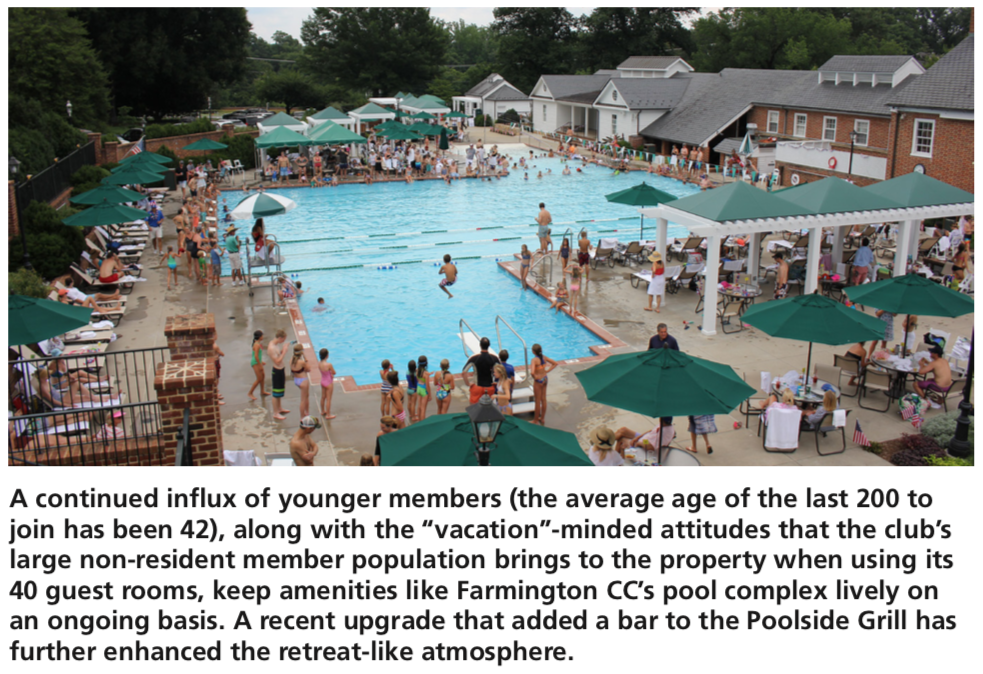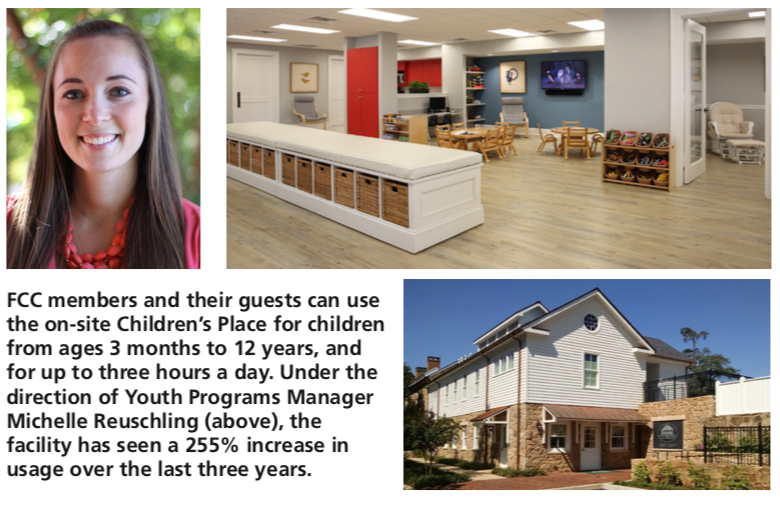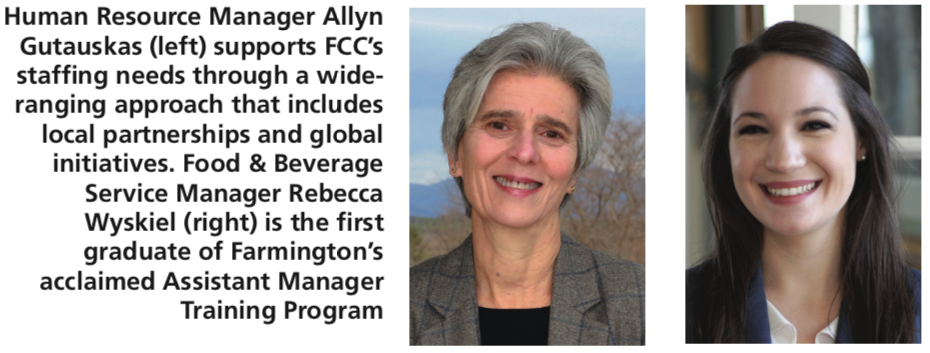The management and operations team at the Charlottesville, Va. property has found innovative ways to keep an eye to the future while preserving their club’s unique ties to history.
With many clubs now reaching historic milestones that coincide with the arrival and spread of golf and country clubs throughout the U.S. from the late 1800s and into the early 1900s, their management and operations staffs are paying increased attention to the responsibilities, and opportunities, that go along with their properties’ places in history.
For the staff at Farmington Country Club (FCC) in Charlottesville, Va., those responsibilities go well beyond when the club was founded in 1927 as part of one of America’s first real-estate development communities. FCC sits on over 280 acres that can be traced to one of the earliest land grants in pre-Revolutionary War Virginia, and portions of its clubhouse, which dates back to 1785, were designed by Thomas Jefferson in 1803,while he was President.
That requires the Farmington staff to carry out duties and provide service for over 2,500 member families within a property that is listed on the National Register of Historic Places and provides special settings like the carefully preserved Jefferson Room for weddings and other functions. But while they are literally not only walking, but working, in this history every day, and also keeping an eye on the need to properly plan for and commemorate the club’s 100th anniversary in 2027, the members of the Farmington team have made sure to stay equally focused on the present, and future, needs of the club and its membership.
This too brings its special challenges, though, as the FCC operation encompasses perhaps the most widespread range of member profiles and usage patterns to be found in the private-club world. In addition to its 1,125 resident members, the club has an even greater number of non-resident members, and a good percentage of those who are in this category joined Farmington because of an affiliation—as alumni, parents of current students, or through other connections—with the University of Virginia in Charlottesville.
There is constant and significant churn within this membership segment, as some non-residents’ children graduate, and new ones matriculate. But it also creates a festive, retreat-like atmosphere, especially during sports and graduation weekends, as non- resident members and their families and guests descend on Charlottesville to use the club “in a vacation state of mind,” as Chief Operating Officer & General Manager Joe Krenn, CCM, CCE, describes.
The staff’s operational duties take on further complexity because of Farmington’s lodging component, including uniquely appointed rooms in the club- house’s oldest wing, that has grown to 40 guest rooms (and 98% weekend occupancy from April to November). “We’ve gone beyond a club operation to really become one with an important travel and tourism aspect for the Charlottesville community, too,” says Krenn.
No Rest for the Leaders
With all of this occurring on a regular basis, members of the Farmington team could certainly be excused for wanting to at least take a breath as 2018 began. The end of 2017 not only marked the completion of the first phase of a long-range facilities improvement plan for FCC, with $13 million spent on a series of projects over the previous four years, it also culminated with recognition of Krenn through the Excellence in Club Management Awards.
But as Krenn stressed when accepting that award on behalf of his team, while payoffs from the work that had been done to date were already pouring in, the approach that he and his staff shared about what now lay ahead for Farmington CC was still very much one of “We’re just getting started.”
And those in charge of the activities and amenities that are out front and visible at the Farmington property have clearly taken that directive and run with it.
For golf, that now means helping members make the most of the club’s new 10-hole East Course and Golf Performance Center with indoor hitting bays, both of which opened last year.
The new “hybrid” East Course, shaped by Coore & Crenshaw from nine existing “spare” regulation holes, has total yardage of just over 2,200 yards from the longest of its three sets of tees—but ends with a par-5 10th hole that is 412 yards from the tips, and also includes three par-4s that range from 257 to 375 yards at their longest.
As evidenced by those twists, the East Course was not designed as a beginner’s or short, par-3 executive emphasizes FCC’s 25-year Head Golf Professional, Rob McNamara.
“It’s a shotmaking course that is just long enough to be rated,” McNamara says. “We’ve had people playing it in 40 minutes, but it’s also fun and challenging enough that we’ve had some go around three times to play 30 holes, and still only take two hours.”
 The new Performance Center, which also includes a full complement of the latest video analysis and instructional tools, has also proved to be an immediate hit, McNamara reports. Lessons revenues are on pace to be double in 2018 what they were two years ago, he says, which has led to the hiring of two new golf pros, including a full-time Director of Instruction, Scott Adland.
The new Performance Center, which also includes a full complement of the latest video analysis and instructional tools, has also proved to be an immediate hit, McNamara reports. Lessons revenues are on pace to be double in 2018 what they were two years ago, he says, which has led to the hiring of two new golf pros, including a full-time Director of Instruction, Scott Adland.
With heating coils installed in the asphalt driveway that leads to the Center, McNamara doesn’t anticipate any fall- off in activity even when winter brings ice or snow—and in fact, he has already seen the Center prove to be a popular destination for groups that want to hit balls while also gathering to watch telecasts of UVA basketball or other events in its comfortable entrance lounge.
The new East Course and Performance Center (which includes an outdoor driving range in front of the indoor bays) join Farmington’s Main Course, which has served as the host course for top Virginia amateur events, including the Kenridge Invitational since 1932, in benefitting from special conditioning and aesthetic advantages, because FCC divides its course and grounds duties into two distinct departments, each with experienced leadership.
There is no overlap between the operations that have been led for 16 years by Golf Course Superintendent Scott Kinnan and for 30 by Grounds Manager Janet Rogers, each of whom has a full-time staff. That allows Kinnan and his team to focus on the main golf course, which can have as many as eight tees on some holes to accommodate all levels of play, as well as the new East Course and practice areas.
Rogers, meanwhile, not only directs the spectacular landscaping that can be found throughout the property, but she and her staff also contribute special gardening instruction to the club’s camps and other youth and member programs.
Changing With the Times
Just as it has adapted its golf programming to adjust to changing preferences for the sport, Farmington has also been quick to spot and address shifts in other areas that are redefining how members want to use the property and add value to their club experiences.
Tennis has seen especially strong growth at FCC since the arrival in 2013 of Ronnie Hass, USPTA, as the club’s Director of Racquet Sports. Not only has participation more than doubled, but 70 of the last 100 members to join the club have been tennis players.
But at the same time, Hass and the club’s leaders have focused on developing plans to respond to that growth by pursuing court expansions, for both indoor and outdoor play, as part of the next phase of facilities improvement at the club, they haven’t taken their eye off other emerging trends.
When pickleball was introduced earlier this year at FCC, Hass says, the strong and immediate response necessitated turning people away from initial clinics and setting up waiting lists. Even better, he adds, most of those who expressed such enthusiastic interest were people he hadn’t seen on any of the club’s tennis courts. Because pickleball “brought a whole new group out,” Hass says, he thinks the sport could eventually “get as large as tennis” has become at FCC. He also sees still more growth potential for the club’s paddle tennis program (Farmington also currently has three paddle courts).
With all of these new recreational attractions in motion, FCC also recognized the need to minimize any impediments that might stand in the way of members making full use of the club’s facilities. That led to the expansion of the on-site Children’s Place facility (see photos, opposite page) as well as staffing of a Youth Programs department, currently managed by Michelle Reuschling, that also focuses on teen and family programming through camps and other activities.
The ability of members to take advantage of the time freed up by using the Children’s Place, which goes beyond child-minding to also include educational and play activities, has helped to boost the across-the-board growth that FCC has seen in all areas (overall operating revenues have nearly doubled in five years, and Krenn reports that member usage levels are at an all-time high).
One department that has certainly gained a boost from how the Children’s Place helps members make full use of the property is food and beverage, which has grown in five years from $3.8 million to $5.2 million—no easy task, Krenn points out, in Charlottesville’s food-town environment, with well over 400 restaurants in the area competing for the business of about 160,000 residents, along with university visitors.
In addition to the conveniences now offered for diners on the property, Farmington’s F&B profile has been boosted by new facilities including the Blue Ridge Room, an adult dining and cocktail space, as well as the upgraded Grill and Pub, with new covered outdoor patio space. There have also been innovations such as the club’s food truck and the development of branded products, including a proprietary “1927” beer and signature ice cream, granola and cookie batter.
Most of all, though, F&B at FCC has been lifted to new levels through the combined food and service excellence directed by Executive Chef Michael Matarazzo, CEC, and Club Manager Brandon Johnson. Because of having overnight guests, maintaining those high standards can be particularly challenging, Krenn notes; Farmington never closes and its F&B service includes breakfast and runs from 7 a.m. to 10 p.m. each day. But as Krenn detailed for C&RB’s Chef to Chef magazine’s August 2016 issue (“How Farmington CC is Establishing Its F&B Identity”), the culinary and service team has helped FCC evolve to where “Members [now] come to the club to eat, instead of eating because they’re already at the club.”
The ultimate endorsement of how the Farmington CC team has succeeded in creating a compelling story for the future comes from its membership numbers—and here, too, Krenn notes, the size and nature of the club, especially because of its larger and ever-changing non-resident segment, brings special challenges. Each year, attrition and natural churn combine to create the need for FCC to find over 100 new members. But the club has still seen five years of net growth for resident members and an overall 8% increase in that category, along with four years of net growth and a 6% increase on the non-resident side.
Keeping dues increases minimal by improving to break-even operating performance for the first time (and in construction years) during that period certainly contributed to that net growth. But another factor was simplication of the membership process, through elimination of four categories and a streamlining of admission requirements.
Tom Zimmermann, the club’s Membership Director for the past 11 years, says those changes have proved effective enough that he can see the trend continuing to the point where “in the not so distant future, we may have just one membership category.”
At the same time, Zimmermann recognizes that the biggest driving force behind the sustained membership growth has been all the changes that have been seen throughout the property, “There’s been a big shift in the culture,” he says. “I have members calling me now and asking, ‘Can you meet somebody?’ There’s clearly a lot of pride in what we have here now.”
Behind the Scenes
Another key component for maintaining Farmington’s momentum has been how the club staff—as well as its Board of Directors, when setting long-term strategies and formulating the property’s master plan—have all stayed laser-focused on viewing membership- related issues in the context of “3 Rs”: Relevance, Retention and Recruitment.
And much of the valuable intelligence that is being applied to put those concepts into action and yield tangible results is being generated behind the scenes through the support of Farming- ton’s finance, information technology and human resources departments.
The IT department has helped to provide the club’s department managers with detailed reports, generated through its operating system software and a free Microsoft tool, Power BI, that pulls real-time data for accounting, inventory and payroll into a single, live, 360-degree dashboard view of the operation. The department heads now use the reports to identify member trends, spending and usage patterns, and staffing efficiencies, so they can evaluate the effects that facility capacity and usage are having on the member experience.
With these reports, says Curtis Kidd, FCC’s Director of IT, department managers can drill down week over week, month over month and year over year to get information for making decisions that help to ensure an optimal member experience, while keeping costs low.
The club has also been taking advantage of efficiencies brought about through the use of software that helps the staff optimize the way it manages and processes accounting-related information and inquiries.
On a busy summer day, activity at FCC can produce more than 1,000 receipts across all of its business departments, and answering a member‘s question about an item on a monthly billing statement was requiring a manual search of thousands of those receipts. The club tried to digitize the receipts by manually scanning them into a shared network folder, but that proved to be a time-consuming process that eventually overloaded the network.
Kidd then found a software solution, M-Files, that is now used by the accounting staff to locate receipts in a matter of seconds, greatly improving member-service satisfaction while also optimizing productivity by eliminating repetitive tasks and saving labor and costs. The system has also helped to streamline the process for managing invoices, budgets and forecasting across the club’s various departments.
With over 200 full-time employees at FCC and another 200 that are part-time and seasonal, the system also has the potential to help streamline the club’s onboarding process, Kidd notes, by maintaining employee personnel files.
Farmington’s human resources department is also supporting the “3R” approach through what Human Resource Manager Allyn Gutauskas describes as “a systematic, strategic and proactive approach to workforce planning and anticipating staffing needs.” Key components of the wide-ranging approach that Farmington takes to meet these goals, Gutauskas adds, include strategic partnerships with local organizations that promote the significance of FCC within the community. There have also been global initiatives, through which the club has hired over 100 refugees to date from African and Middle Eastern countries and helped them learn English and assimilate to a new life in a new world while working in the club’s housekeeping, banquet or kitchen departments.
Farmington is also well-recognized within club industry circles for the success of its Assistant Manager Training Program, now in its fifth year. One new manager begins the four-year program each year, and the first graduate, Rebecca Wyskiel, is now FCC’s Food and Beverage Service Manager.
During her time in the program, Wyskiel did everything from working in the laundry to cutting grass as she rotated through different operating departments on a self-guided schedule. She then made a presentation to Farmington’s Board on all that she learned during her time at the club—and at the same time, Krenn says, showed why she was an “obvious choice” for a full- time position.
The efforts by FCC’s administrative departments to help their fellow managers on the front lines through data- mining, staffing initiatives and finding automated efficiencies are all critical to helping a large operation like Farmington thrive in a smaller and always- changing market, says Chief Financial Officer Julie Brown, CPA.
“This is a very complex business,” says Brown, who came to FCC shortly after Krenn, after previously working in financial positions for a construction firm. “You need to work every strategic angle you can, and be as data-driven as possible when making decisions.
“With the right tools and analytics, you can be very nimble and not only maximize value for those who are using the club, but also identify members at risk and take steps to engage them again as well,” Brown notes. “And you can feel more confident trying something new, because you’ll have data to tell you it should work—and then after you try it, to quickly tell you if it’s not.
“That’s why we’re always trying new things, even if it’s something small, to keep the club fresh,” she adds. “We rarely say no to something the staff wants to try—and we’re certainly never bored.”



